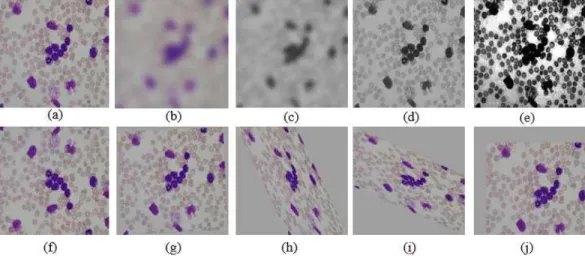1. INTRODUCTION
Leukemia, a kind of cancer found in blood and bone marrow, is a dangerous cancer-causing 24,500 deaths in the United States in 2017 [1].
About 62,130 new cases of leukemia have been de- tected in 2017, leading a large number of patients required to be diagnosed. Clinically and pathologi- cally, leukemia is subdivided into four main groups, acute myelogenous leukemia (AML), acute lym- phoblastic leukemia (ALL), chronic lymphocytic leukemia (CLL), and chronic myeloid leukemia
(CML). Among these, ALL and AML are known as the most dangerous types. Thus, the early de- tection and timely treatment of ALL and AML is essential to substantially prevent the rapid devel- opment of cancerous cells. According to the Cancer Treatment Centers of America [2], the acute types of leukemia (AML and ALL) can be classified based on the type of cell involved and how the cells look like under a microscope. For instances, the normal white blood cell, colored purple in Fig. 1 (a), has the similar size to that of surrounding red blood cells, while the leukemia blood cell has an
Classification of Leukemia Disease in Peripheral Blood Cell Images Using Convolutional Neural Network
Thanh Tran
†, Jin-Hyuk Park
††, Oh-Heum Kwon
†††, Kwang-Seok Moon
††††, Suk-Hwan Lee
†††††, Ki-Ryong Kwon
††††††ABSTRACT
Classification is widely used in medical images to categorize patients and non-patients. However, conventional classification requires a complex procedure, including some rigid steps such as pre- processing, segmentation, feature extraction, detection, and classification. In this paper, we propose a novel convolutional neural network (CNN), called LeukemiaNet, to specifically classify two different types of leukemia, including acute lymphoblastic leukemia (ALL) and acute myeloid leukemia (AML), and non-cancerous patients. To extend the limited dataset, a PCA color augmentation process is utilized before images are input into the LeukemiaNet. This augmentation method enhances the accuracy of our proposed CNN architecture from 96.9% to 97.2% for distinguishing ALL, AML, and normal cell images.
Key words: Acute Leukemia, Convolutional Neural Network, Data Augmentation, Deep Learning, Image Classification
※ Corresponding Author : Kwang-Seok Moon, Address:
(608-737) 599-1, 45 Yongso-ro, Namgu, Busan, Korea, TEL : +82-51-629-6257, FAX : +82-51-629-6230, E-mail : kiryongkwon@gmail.com
Receipt date : Jul. 6, 2018, Revision date : Aug., 14, 2018 Approval date : Sep. 10, 2018
††
Dept. of IT Convergence and Application Engineering, Pukyong National University
(E-mail : thanhttp02@gmail.com)
††
Dept. of IT Convergence and Application Engineering, Pukyong National University
(E-mail : detdetplus@naver.com)
††††††
Dept. of IT Convergence and Application Engineer- ing, Pukyong National University
(E-mail : ohkwn@pknu.ac.kr)
††††††
Dept. of Electronics, Pukyong National University
††††††
Dept. of Information Security, Tongmyong University (E-mail : skylee@tu.ac.kr)
††††††


